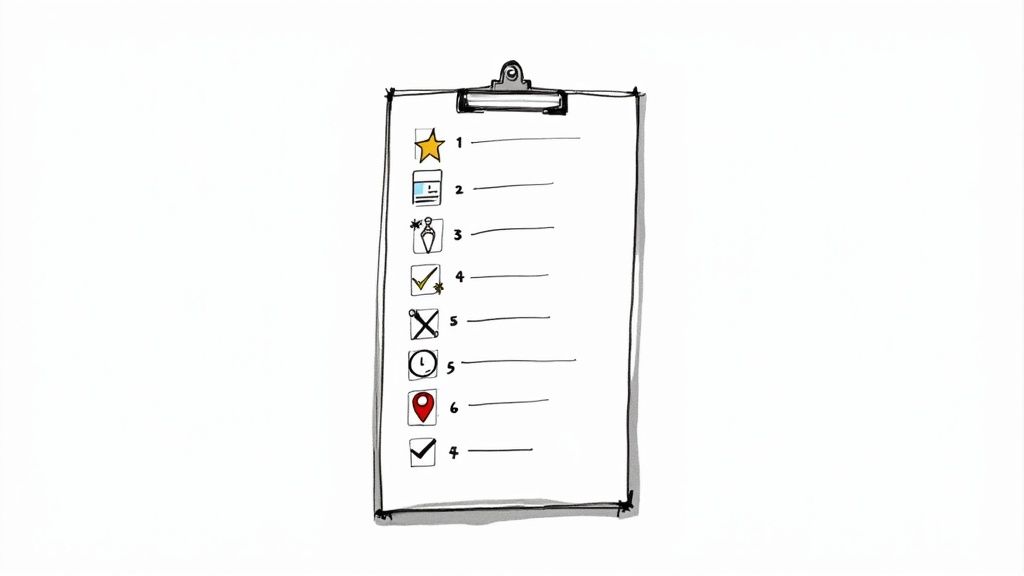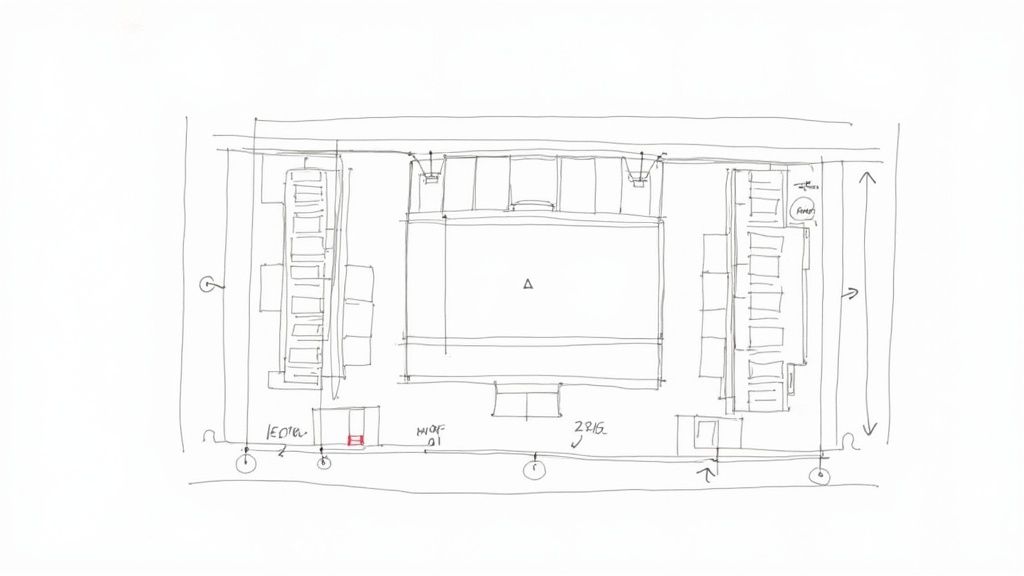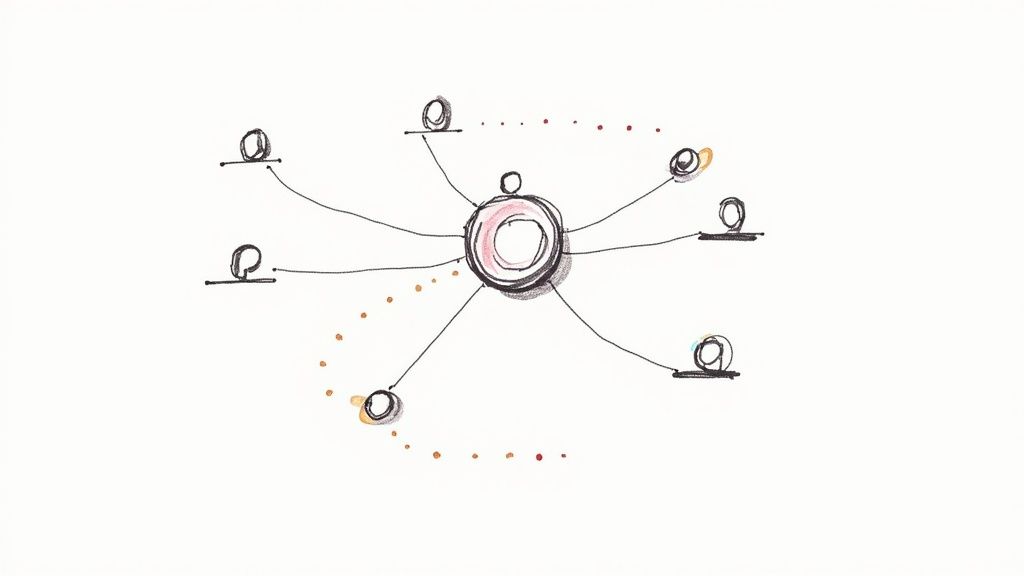October 31, 2025

The confetti has settled, the last guest has departed, and the venue is quiet. But your work as an event organizer isn't over. The most crucial phase is just beginning: understanding what truly resonated with your attendees and what fell flat. Moving past generic feedback like "it was good" requires asking smarter, more targeted questions that reveal the why behind attendee sentiment. To truly elevate your future events, you need a strategic approach to gathering this valuable data.
This guide provides a comprehensive roundup of essential event feedback survey questions, organized into 10 distinct categories. Each section is designed to move beyond simple satisfaction scores and uncover the specific, actionable insights that drive real improvement and demonstrate value to stakeholders.
You will learn how to precisely measure everything from content relevance and speaker effectiveness to the quality of networking opportunities and overall event ROI. By implementing these structured questions, you will be equipped with the concrete data needed to refine logistics, enhance the attendee experience, and build a loyal community that returns year after year. We'll get straight to the questions that matter, helping you transform attendee opinions into your most powerful planning tool.
The Overall Satisfaction Rating is a cornerstone of effective event feedback survey questions. It typically asks attendees to rate their experience on a 0-10 scale, serving as a powerful, high-level indicator of event success. This method, popularized by Fred Reichheld’s Net Promoter Score (NPS) system, is designed to measure attendee loyalty by asking how likely they are to recommend your event to a friend or colleague.

This single question provides a quantifiable metric that is easy to track over time. Leading platforms like Eventbrite and SurveyMonkey integrate this question format, while major conferences such as SXSW rely on it to gauge year-over-year performance and make strategic improvements. The resulting score helps segment your audience into Promoters (9-10), Passives (7-8), and Detractors (0-6), giving you a clear snapshot of sentiment.
To get the most value from this question, context and follow-up are key. It should be one of the very first questions in your survey, as it captures the attendee's immediate, overall impression.
Beyond overall satisfaction, the value of your event is fundamentally tied to its content. Questions about content quality and relevance are critical event feedback survey questions that dig into the core substance of your programming. They help you determine if your sessions, speakers, and topics resonated with your audience and delivered on their educational or professional expectations.
This type of feedback is essential for continuous improvement. Academic conferences rely on speaker ratings to inform future programming, while corporate training events use it to measure how applicable the content was to attendees' daily roles. Virtual event platforms like Hopin even build content satisfaction metrics directly into their analytics, underscoring its importance in gauging an event’s success and demonstrating ROI to stakeholders.
To get granular, actionable feedback, you must ask about content in a structured and specific way. This allows you to pinpoint high-performing sessions and identify areas needing a content refresh.
Questions about venue and logistics satisfaction are critical for understanding the attendee's physical or digital journey. These event feedback survey questions assess everything from the comfort of the venue and ease of parking to the stability of a virtual event platform. A seamless logistical experience is foundational; if attendees struggle with basic access, comfort, or technology, it will negatively impact their perception of the entire event, regardless of content quality.

This category of feedback is essential for both physical and virtual events. Music festivals like Coachella use this data to optimize traffic flow and on-site amenities, while major virtual conference platforms like Hopin and vFairs rely on it to improve user interface and technical stability. For corporate conferences, feedback on the registration process can directly inform choices for a smoother check-in experience. By isolating logistical factors, you can make targeted operational improvements that significantly enhance the overall attendee experience.
To gather actionable logistical feedback, you must be specific and cover the entire attendee journey, from arrival to departure.
For many attendees, the true value of an event lies in the connections they make. Questions about networking opportunities are essential event feedback survey questions that measure how successfully you facilitated meaningful interactions between peers, speakers, and exhibitors. They gauge everything from the quality of conversations to the effectiveness of dedicated networking spaces or digital tools.

Evaluating networking is a priority for platforms like LinkedIn and Eventbrite, which recognize that connections drive long-term value. Major professional associations like the IEEE and ACM use this feedback to design better-structured coffee breaks, receptions, and matchmaking sessions. By asking about networking, you gain insight into the social ROI your event delivered, which is often a key reason people attend in the first place. For tips on maximizing these interactions, you can learn more about professional networking tips.
Effective networking questions go beyond a simple "Did you meet new people?" and dig into the quality and context of the connections made.
Evaluating speakers and presenters is a critical component of event feedback survey questions, as the quality of delivery can make or break an attendee’s experience. These questions focus specifically on the presenter's performance, assessing their communication skills, engagement level, and overall effectiveness, separate from the content itself. This distinction allows you to identify top-performing speakers and pinpoint specific areas for improvement.
This focused evaluation is a hallmark of organizations that prioritize high-quality presentations. For instance, TED Talks and Toastmasters International have built their reputations on rigorous speaker coaching and feedback loops. Similarly, major academic and corporate conferences use detailed speaker ratings not only to enhance future events but also to provide valuable career development feedback to presenters. By isolating delivery from content, you gain clearer, more actionable insights into what truly captivates your audience.
To gather meaningful data on speaker effectiveness, your questions must be specific and well-structured. This approach helps you move beyond a simple "good" or "bad" rating to understand the nuances of a great presentation.
Questions assessing an event's Value for Money or Return on Investment (ROI) are critical for understanding if attendees felt their investment of time and money was justified. This category of event feedback survey questions moves beyond satisfaction to measure the tangible and intangible benefits received against the cost of attendance, whether it's a ticket price or simply time away from the office.
This financial and practical validation is a key metric for premium conferences, corporate training, and ticketed workshops where attendees (or their employers) expect a clear return. Analyzing responses helps organizers fine-tune pricing, demonstrate value to stakeholders, and improve the overall event proposition. For example, executive retreats often use this feedback to justify high-ticket prices to C-suite attendees by highlighting specific, high-value outcomes. To truly maximize the impact of your events, consider how event feedback contributes to broader strategies to improve marketing ROI.
To effectively gauge perceived value, your questions must be specific and well-timed. Frame them to uncover what attendees valued most, rather than just asking if the price was right.
While the NPS-style question measures general sentiment, asking specifically about the likelihood to recommend or attend again hones in on future behavior and event loyalty. This question directly measures an attendee's intent, providing a clear forecast of future growth through word-of-mouth marketing and repeat attendance. It moves beyond satisfaction to capture a concrete commitment.

This approach is vital for organizations focused on sustainable growth. For example, annual conferences rely on this data to predict retention rates and adjust marketing budgets, while community-focused meetups use it to gauge member loyalty. By asking these direct event feedback survey questions, you gain a tangible metric for your event’s long-term viability and its ability to build a dedicated audience.
To get actionable data, you need to be specific and create opportunities for deeper insights. This question is most effective when placed after overall satisfaction to gauge how sentiment translates into action.
Assessing the event’s organization and communication is fundamental to understanding the attendee journey from start to finish. These event feedback survey questions evaluate everything from pre-event emails and website clarity to onsite signage and schedule management. A well-organized event feels seamless and professional, directly impacting attendee satisfaction and their perception of your brand.
This category of questions uncovers friction points in the logistical experience. For example, large-scale trade shows like CES rely on this feedback to optimize attendee flow and signage, while corporate event planners for companies like Google use it to ensure agenda clarity and timing adherence are flawless. The insights gathered help pinpoint operational weaknesses and highlight what's working well.
Effective implementation requires breaking down the event timeline into distinct phases and focusing on specific logistical elements. This approach provides granular, actionable data rather than vague, general feedback.
Evaluating an event's commitment to diversity, inclusion, and accessibility is no longer optional; it's essential for creating a welcoming and equitable environment. These event feedback survey questions assess how well the event catered to attendees from all backgrounds, abilities, and identities. This includes everything from physical accessibility to the diversity of speakers and content.
This category of questions provides critical insight into whether your event truly served its entire community. Major tech conferences, for instance, now use this feedback to measure and improve gender and ethnic representation on stage and in attendance. Likewise, international forums rely on it to ensure cultural and linguistic needs are met, making it a key metric for modern event success.
To gather meaningful feedback, your questions must be specific, respectful, and action-oriented. Integrating them thoughtfully into your survey shows attendees that you genuinely care about their experience and are committed to improvement.
While structured questions provide quantifiable data, open-ended feedback is essential for capturing the nuanced, qualitative insights that ratings alone cannot. This type of question invites attendees to provide free-form suggestions, highlight specific positive experiences, or describe problems they encountered. It is a critical tool for discovering improvement opportunities you may not have anticipated.
This qualitative approach is a staple for user experience researchers and customer-centric organizations. For instance, many industry conferences use a simple “Suggestions for next year?” box to gather innovative ideas directly from their audience. Similarly, platforms like SurveySparrow now integrate sentiment analysis to automatically categorize the tone of open-ended text, making it easier to process large volumes of responses and identify key themes without manual sorting.
To maximize the value of open-ended event feedback survey questions, you must be strategic in how you ask and analyze them. The goal is to encourage thoughtful responses without overwhelming the attendee or your data analysis team.
Asking the right event feedback survey questions is the critical first step, but the journey from data collection to event evolution is where the real transformation happens. This comprehensive list of question categories, from assessing overall satisfaction with NPS-style queries to digging into the specifics of content, speakers, and logistics, provides a powerful toolkit. It’s a blueprint for moving beyond generic, surface-level inquiries and capturing the nuanced insights that drive meaningful improvement.
Remember, the goal isn't just to gather data; it's to start a conversation. Each response, whether a glowing review of a keynote speaker or a critical note about networking opportunities, is a valuable piece of your event's story. Your attendees are telling you exactly what they need to feel engaged, inspired, and valued.
The true power of this process is unlocked when you commit to a cycle of listening, analyzing, and acting. To make your efforts count, focus on these key takeaways:
Mastering the art of asking strategic event feedback survey questions and, more importantly, acting on the answers, is no small feat. It’s the difference between hosting a one-off gathering and building an unmissable, recurring experience that grows stronger each year. By treating feedback as a strategic asset, you're not just refining logistics; you are co-creating future events with your most important stakeholders: your attendees. This commitment to continuous improvement is what elevates a good event to an unforgettable one, ensuring sustained engagement and long-term success.
Ready to streamline your entire event process, from ticketing and registration to collecting and analyzing powerful feedback? GroupOS provides an all-in-one platform that integrates these crucial functions, helping you effortlessly turn attendee insights into a repeatable formula for success. Discover how GroupOS can transform your event strategy today.


